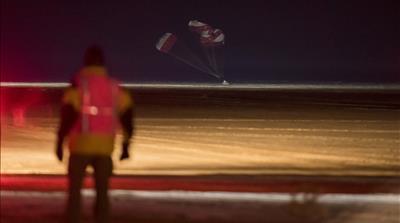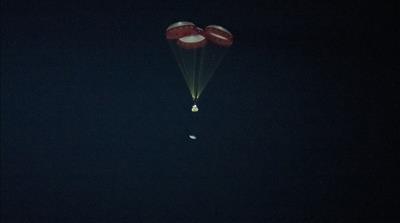Boeing Starliner is back on Earth
Space capsule safely on the ground, seven-day mission ends after just 49 hours.

It came from a soft-spoken, but serious voice. When the words: “Tally-ho” came across the communications link connecting the flight control team to the landing and recovery team thousands of miles away, it signalled that Boeing’s Starliner space capsule was finally in sight of the ground.
With the touchdown confirmed, the flight-control team in Cape Canaveral, Fla. handed responsibility for the craft over to the landing and recovery team at the United States Army’s White Sands Missile Range in New Mexico. It was then NASA Administrator Jim Bridenstine high-fived people in the control room and shared a hug with Leanne Caret, Boeing’s Defense, Space & Security president and chief executive officer.

Flying without a crew on board, Boeing’s CST-100 Starliner touched down at 5:58am MST, making it the first-ever on-land landing of a US-made spacecraft. The pre-dawn landing concluded an orbital flight test (OFT) that suffered a non-critical, but significant error that prevented the spacecraft from reaching the International Space Station (ISS), an important milestone.
Keep reading
list of 3 itemsBoeing Starliner astronaut capsule won’t complete its mission
NATO declares space an ‘operational domain’
“On Friday after the separation of the vehicle from the launch vehicle, we had some challenges,” Bridenstine said in a post-touchdown news conference. “We had to test the vehicle itself. We had to test entry, descent, and landing.”
He added: “In fact, you could argue that some of the hardest parts of this mission have now been proven to be very very capable … You look at the landing it was an absolute bull’s-eye.”
The flight-control team kicked off Starliner’s return from 250 kilometres (155 miles) above the earth with a deorbit burn at 7:23am EST. In the following 25 minutes the capsule separated from the service module, deployed three main parachutes to slow the craft, which had started its descent at 25 times the speed of sound.

At an altitude of roughly 900 metres (2,952 feet) the capsule released its bottom heat shield and inflated six airbags for a landing at 7:58am EST. It took about an hour for ground crews to open the hatch and greet Rosie the Anthropomorphic Test Device, which had taken the trip in the commander’s chair.
The Starliner circled the Earth 33 times over two days, one hour 21 minutes. The spacecraft designed to carry humans was originally slated to carry out over seven days a series of on-orbit docking test manoeuvres, as well as deliver supplies and Christmas present to the ISS crew.
Boeing is competing with SpaceX to develop commercial launch systems to restart NASA’s human spaceflight capacity. SpaceX already launched an unmanned Crew Dragon spacecraft to the ISS last March, moving CEO’s Elon Musk’s upstart company ahead of the aerospace giant in terms of proven technical capabilities.
Under a cloud of schedule delays and accusations of financial waste, on Friday, the Starliner failed to reach the necessary orbit with enough fuel to make its planned rendezvous with the ISS. While the details are still murky and are being analysed, the NASA administrator said a software glitch in the capsule’s automated mission-elapsed timing system, a clock, caused an unnecessary fuel burn to occur at just the wrong time.